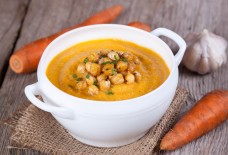Anissa Helou Discusses Her Favorite Recipes — and Camel Humps
SOURCE: LOS ANGELES TIME
BY: ANISSA HELOU AND EVAN KLEIMAN
Most recently the author of “Feast: Food of the Islamic World,” Anissa Helou grew up in Beirut with a Syrian father and Lebanese mother, and wrote her first book about Lebanese food in 1994. Now, she lives in Sicily (“It has everything that I was brought up with: seasonality, sunshine, the sea, lovely people, hospitality. But there is no ISIS,” she explains), but she’s still writing about the food of the Islamic world — “Feast” collects recipes from Muslim cultures ranging from Indonesia to Iran and India to Qatar. At Now Serving, Helou talked with Evan Kleiman about her research tactics, her favorite biryani recipe, and a one-time plan to make lardo from a camel’s hump.
This interview has been edited and condensed.
On essential foods in the Muslim world:
Bread is an absolute staple almost everywhere in the Muslim world. Even in cultures where bread is not essential, there is bread. There’s also what I call the whole beast: animals that are killed to serve them at feasts and celebrations. And sweets, of course, because they are very much part of the hospitality, which is very important in the Islamic world.
On her favorite recipes:
Before I started researching the book, I thought there were two or three different biryanis. When I started traveling, I realized I could have an entire section on biryanis; it’s a very important dish served at weddings and celebrations that goes from India to Pakistan to Indonesia to the Arab Gulf.
As for sweets, kunafeh is my favorite. It’s a sweet cheese pie made with hair pastry. The pastry is baked first, and then the cheese is laid on top. Then you pour a lot of syrup on, and if you want to be totally sinful, you make a sandwich.
On her research methods:
Before I travel, I consult chefs and friends. Once I’m there, I talk to anyone I think is going to be inspiring or useful. The ideal situation is to see them cook in action; that’s how you understand a recipe. I’m always on the lookout for interesting food people, and because I’ve been doing it for a long time, I kind of have a nose for it.
I was in a market in Uzbekistan not so long ago, where I saw this wonderful looking man talking to two bread ladies. I zoomed over and started talking to him. It turned out that he was an ex-military guy. We had a really interesting conversation about decorated breads that are shown on the bridal table, not necessarily to eat.
On camel humps:
I was filming a series called “The Chef Discovers,” going around the Emirates and learning how to cook things. One of the episodes was about a camel party. The prize piece of the camel is the hump. But when we arrived at the party, the producer said, “You can’t come with us, you’re a woman.” And I said, “What about the hump? How am I going to taste the hump if I can’t go to that party?”
As luck would have it, two days later I was in a catering kitchen and they were cooking another camel for another party. The chef was really nice and he cut out a little piece of meat … but it was an anticlimax, because it wasn’t really good. Jonathan Gold and I once had a plan to make lardo with camel fat, but it never came to anything.
Then I had the idea of writing an article about camel hump. I ended up at the slaughterhouse (like an idiot, quite well-dressed, in suede moccasins and a white shirt), and they brought a beautiful baby camel out. They slit the throat and butchered it and they gave me the hump, which I was very happy to have. I took it to my brother’s flat in Dubai and put it on the kitchen counter and said, “Today I’m cooking you camel hump.”
I used the same marinade they use for the whole animal. Rosewater, saffron, garlic, lots of spices. I massaged it and roasted it. And I realized that the hump can be good if you have a baby camel, still milk-fed. A Syrian taxi driver told me that the reason they like camel meat is that it’s supposedly a monogamous animal; in Islam it’s good to eat an animal that is faithful to its wife.



